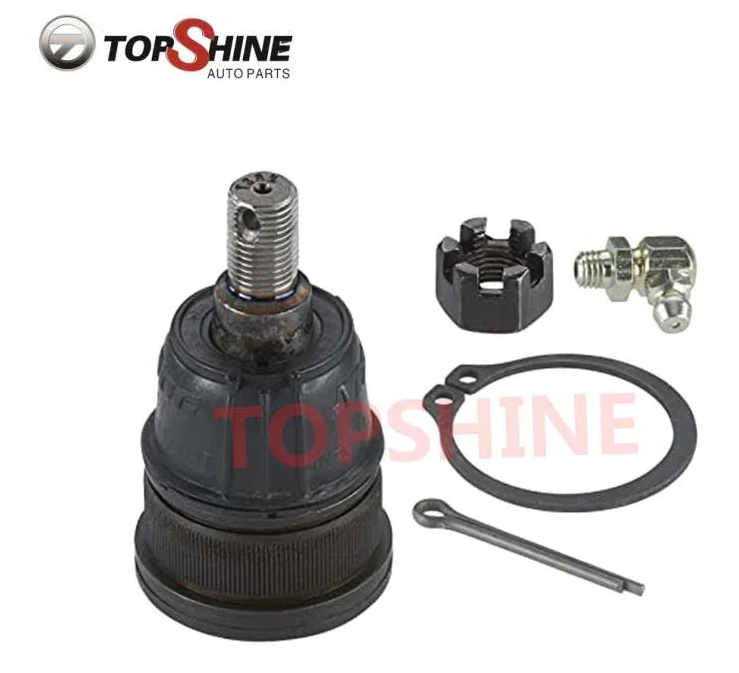Maintaining a vehicle’s suspension system is crucial for safety, steering precision, and ride comfort. Among the most important components of any suspension system are ball joints, which allow for smooth movement of the control arms while supporting the weight of the vehicle. Over time, wear and tear can compromise performance, leading to uneven tire wear, clunking noises, or steering instability.
With the rise of easy-install ball joints, vehicle owners and professional mechanics can now perform replacements quickly, efficiently, and safely. Designed for both OEM and aftermarket use, these components simplify installation while providing durable, high-performance operation.
Topshine, a leading manufacturer of automotive rubber and suspension parts in China, specializes in engine mounts, strut mounts, center bearings, bushings, control arms, ball joints, and tie rod ends. Operating under the TS16949 quality management system, Topshine guarantees products that meet rigorous standards for fitment, durability, and performance.
This comprehensive guide will cover everything you need to know about easy-install ball joints, from types and selection criteria to installation, maintenance, and future trends.
1. Types of Ball Joints
Understanding the different ball joint types is critical for selecting the right part for your vehicle:
1.1 Press-In Ball Joints
Press-in ball joints are installed by pressing directly into the control arm.
-
Advantages: Strong, durable connection, suitable for high-load suspension systems.
-
Considerations: Requires specialized tools and professional installation.
1.2 Bolt-On Ball Joints (Easy Install)
These modern ball joints are designed for quick replacement without pressing tools.
-
Advantages: Time-saving, DIY-friendly, reduces risk of incorrect installation.
-
Applications: Common in aftermarket replacements and vehicles with easily accessible control arms.
1.3 Load-Bearing vs. Non-Load-Bearing Ball Joints
-
Load-Bearing: Supports the vehicle’s weight and is usually installed in front suspension systems.
-
Non-Load-Bearing: Guides suspension movement without bearing weight, typically used in rear suspensions.
Topshine manufactures all these types, ensuring broad compatibility with most vehicle models, including cars, SUVs, trucks, and light commercial vehicles.
2. Key Considerations When Choosing a Ball Joint
Selecting the right ball joint is crucial for performance, safety, and longevity. Here are the main factors to consider:
2.1 Fitment and Compatibility
-
Always verify vehicle make, model, year, and suspension type.
-
Using an incompatible ball joint can cause steering issues, uneven tire wear, and suspension failure.
2.2 Material and Durability
-
Look for hardened steel components for strength.
-
High-quality rubber boots protect against dirt, debris, and moisture, extending the service life.
2.3 Pre-Greased vs. Serviceable
-
Pre-greased joints are ready for installation, reducing maintenance needs.
-
Serviceable joints allow periodic lubrication, extending operational life.
2.4 Load Capacity and Driving Conditions
-
Light passenger vehicles may use standard-rated joints.
-
Trucks, SUVs, or off-road vehicles require heavy-duty, reinforced ball joints capable of handling greater loads and rough terrain.
2.5 Installation Type
-
Bolt-on easy-install designs simplify replacement.
-
Reduced labor and error risks make them ideal for DIY mechanics and aftermarket workshops.
3. Installation Guide for Easy-Install Ball Joints
Proper installation is critical for safety and performance. Here’s a step-by-step guide:
3.1 Preparation
-
Lift the vehicle using a jack and secure with jack stands.
-
Remove the wheel and disconnect suspension components obstructing access.
3.2 Removing the Old Ball Joint
-
Loosen bolts or press out the old joint as needed.
-
Inspect surrounding parts, such as the control arm, tie rods, and bushings, for wear.
3.3 Installing the New Ball Joint
-
Align the joint with the control arm and steering knuckle.
-
Bolt or press in as instructed by the manufacturer.
-
Torque to the recommended specifications to ensure safety.
3.4 Final Checks
-
Ensure free movement of the joint and proper suspension articulation.
-
Reinstall the wheel and perform a test drive to verify steering response.
-
A professional wheel alignment is recommended for optimal performance.
Topshine easy-install ball joints are specifically engineered to simplify these steps, making replacements safer and faster.
4. Signs That Your Ball Joints Need Replacement
Recognizing the early signs of wear can prevent suspension failure and costly repairs:
-
Clunking or squeaking noises from the suspension
-
Uneven or rapid tire wear
-
Steering wheel vibrations at higher speeds
-
Loose or unstable steering feel
-
Torn or damaged rubber boots
Timely replacement with Topshine ball joints restores vehicle stability, steering precision, and overall safety.
5. Maintenance Tips for Longevity
Even easy-install ball joints benefit from proper maintenance:
-
Regular Inspection: Check rubber boots for tears or leaks.
-
Lubrication: Serviceable joints require periodic greasing.
-
Suspension Checks: Inspect connected components like control arms and tie rods.
-
Avoid Overloading: Excessive vehicle weight or harsh terrain accelerates wear.
Routine attention ensures your suspension system operates efficiently and safely over the long term.
6. Advantages of Topshine Easy-Install Ball Joints
-
Durable Materials: Hardened steel and premium rubber boots for extended life.
-
Precision Engineering: Perfect fit ensures smooth articulation and alignment.
-
Time-Saving Installation: Bolt-on design reduces labor and simplifies replacement.
-
Pre-Lubricated Options: Minimal maintenance for convenience and reliability.
-
Wide Compatibility: Covers a range of makes and models for cars, SUVs, and light trucks.
-
OEM and Custom Solutions: Supports both branded and custom specifications.
With Topshine, vehicle owners and mechanics gain high-performance, long-lasting, and reliable ball joints suitable for professional or DIY use.
7. Industry Trends and Future Developments
The automotive suspension industry is evolving, with several key trends influencing ball joint design:
-
Advanced Materials: Use of corrosion-resistant alloys and synthetic rubbers to increase durability.
-
Pre-Lubricated and Sealed Designs: Reduce maintenance and improve reliability.
-
Integration with Suspension Monitoring: Smart sensors detect wear in real-time, enhancing safety.
-
Lightweight Construction: Reduces unsprung weight, improving fuel efficiency and handling.
-
Electric and Hybrid Vehicle Applications: Designed to handle higher torque and regenerative braking loads.
Topshine continues to innovate, ensuring products meet the demands of modern vehicles while improving performance and longevity.
8. Choosing Between OEM and Aftermarket Ball Joints
When deciding between OEM and aftermarket options:
-
OEM: Guaranteed fitment, reliability, and brand trust, but often higher cost.
-
Aftermarket (like Topshine): Comparable quality, lower cost, easier availability, and flexibility for upgrades or custom specifications.
Topshine aftermarket ball joints meet or exceed OEM standards, providing durable, high-performance alternatives for global customers.
Conclusion
Replacing worn ball joints is crucial for vehicle safety, ride comfort, and steering performance. Easy-install ball joints save time, reduce labor, and ensure proper suspension function.
Topshine, a leading manufacturer of automotive rubber and suspension parts, offers:
-
High-quality easy-install ball joints
-
Strict TS16949 quality control
-
Durable and precise engineering
-
Wide range of OEM and aftermarket solutions
Whether you are a professional mechanic or a DIY enthusiast, Topshine easy-install ball joints are the smart choice for maintaining vehicle safety and performance.
By selecting Topshine, you ensure long-lasting durability, safe steering, and hassle-free installation, making your suspension system more reliable than ever.
www.topshineparts.com
TOPSHINE AUTO PARTS(NANCHANG)CO.,LTD



